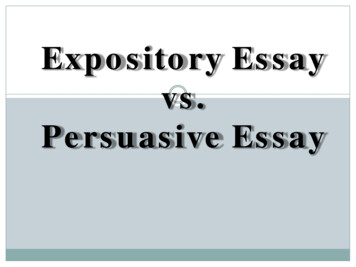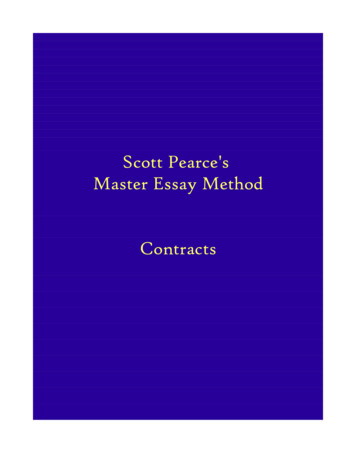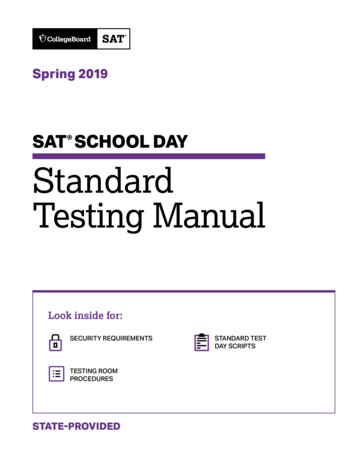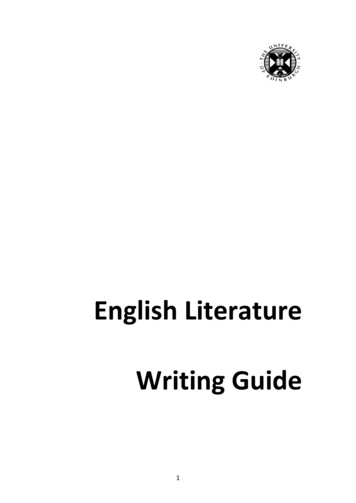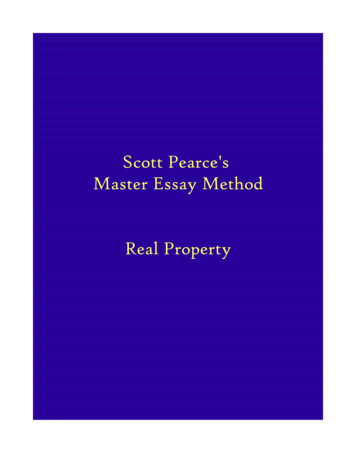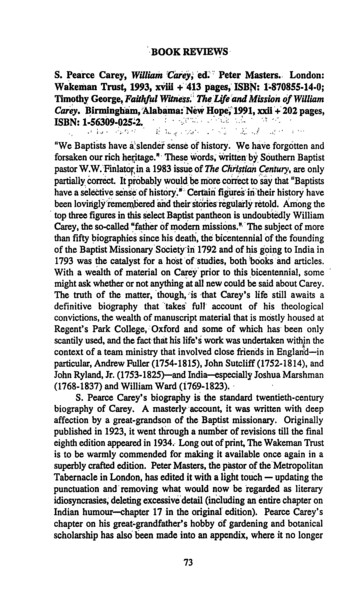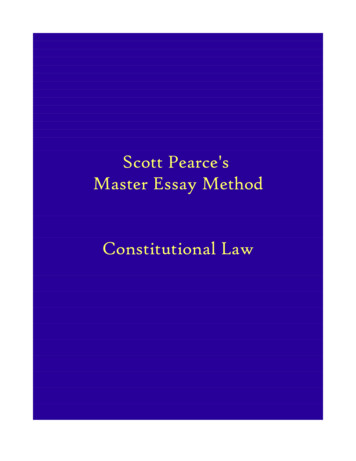
Transcription
Scott Pearce'sMaster Essay MethodConstitutional Law
CONSTITUTIONAL LAW APPROACHI.Identify the Plaintiff's Injury. (Be Specific)II.Identify the Plaintiff.A.If plaintiff is a private party:1.2.B.III.Show that the plaintiff has standing.Consider ripeness and mootness.If plaintiff is a government, consider inter governmental immunities.Identify the Defendant.A.If defendant is a private party, discuss state action.B.If defendant is a state or local government, consider:1.2.3.4.C.Interstate privileges and immunities clauseCommerce clausePre-emption (express / implied)Police PowerIf defendant is the federal government, consider:1.Executive powers (domestic and foreign)2.Judicial powersa.Article III courts (the federal system)b.Article I courts (bankruptcy, etc.)3.Legislative powersa.Interstate Commerce / Postal Authorityb.Taxing and Spendingc.Foreign Affairs and Aliensd.Necessary and Proper Powere.Enabling Clauses of the 13th, 14th and 15th AmendmentsScott Pearce’s Master Essay Method - Constitutional Law Approach
IV.What Constitutional right has been violated?A.B.C.D.1st Amendment Freedom of Expression1.Freedom of Speech (time place and manner)2.Freedom of Association3.Freedom of the Press1st Amendment Freedom of Religion1.Establishment Clause2.Free Exercise ClauseDue Process Clause (5th Amendment - Feds, 14th Amendment - States)1.Procedural Due Process2.Substantive Due Process3.5th Amendment ‘Taking’ CasesEqual Protection Clause of the 14th Amendment1.Determine the standard to be applied to the challenged action.a.b.c.2.V.Strict ScrutinyIntermediate ScrutinyRational BasisEvaluate the action according to the applicable standard.Conclusion: a concise answer to the question.Scott Pearce’s Master Essay Method - Constitutional Law Approach
CONSTITUTIONAL LAWCopyright February, 2007 – State Bar of CaliforniaCity has adopted an ordinance banning tobacco advertising on billboards, store windows, any sitewithin 1,000 feet of a school, and “any other location where minors under the age of 18 traditionallygather.”The purpose of the ordinance is to discourage school-age children from smoking. The likely result ofthe ordinance will be to cause the removal of tobacco advertising from the vicinity of schools, day carecenters, playgrounds, and amusement arcades.The Association of Retailers (AOR) was formed to protect the economic interests of its memberretailers. AOR had unsuccessfully opposed the adoption of the ordinance, arguing that it would causehardship to store owners by depriving them of needed advertising revenue. AOR believes the best wayto discourage young people from smoking is by directly restricting access to tobacco rather than bybanning all tobacco advertising.AOR is considering filing a complaint for injunctive relief against City in federal district court claimingthat the ordinance deprives its members of rights under the Free Speech Clause of the FirstAmendment.What arguments could AOR reasonably make to show that it has standing, and that its FirstAmendment free speech claim has merit, and would it be likely to succeed? Discuss.Scott Pearce's Master Essay Method - February 2007 - Constitutional Law
Constitutional Law – Outline of IssuesCopyright 2007 – Scott F. Pearce, Esq.I.II.Association StandingA.The lawsuit is relevant to the Association’s purpose.B.Individual members of the Association would have standing.C.Individual members will not be required to participate in the proceedings.D.Conclusion: AOR has standing.AOR’s First Amendment free speech argumentsA.Ripeness, Mootness, State ActionB.Commercial SpeechD.1.Substantial Relationship with Important Government Interest2.Ordinance Advances Government Interest3.Narrowly Tailored4.VaguenessConclusion: The statute is void for vaguenessScott Pearce's Master Essay Method - February 2007 - Constitutional Law
Constitutional Law – Model AnswerCopyright 2007 – Scott F. Pearce, Esq.I.Association StandingThe Association of Retailers (AOR) is considering filing a complaint to enjoin City's ban on tobaccoadvertising on First Amendment grounds. The threshold issue is whether or not AOR has standing tosue. The test for Association Standing has three parts: the lawsuit must be relevant to the association'spurpose, individual members would have standing, and individual members will not be required toparticipate in the proceedings. AOR should have little trouble establishing that it has standing to sue.A.The lawsuit is relevant to the Association’s purpose.AOR was formed to protect the economic interests of its member retailers. Even before City'sordinance was enacted, AOR unsuccessfully opposed the adoption of the ordinance. AOR argues thatits member retailers need the advertising revenue they receive from tobacco companies, and thatphysically restricting access to tobacco for young people is better than banning advertising.Preserving a source of income to its member retailers is relevant to the purpose of AOR. This elementis met.B.Individual members of the Association would have standing.City's ordinance bans tobacco advertising on billboards, store windows, near schools and other placeswhere minors traditionally gather. Any individual member of AOR that sustained a loss in revenuewould have standing to challenge the Constitutionality of the ordinance. These individuals will havesuffered a financial harm directly caused by City's ordinance. The injunctive relief sought by AORwould redress their grievances.It is likely that many members of AOR would not have standing as individuals, because many retailoutlets neither sell tobacco nor profit from tobacco advertising. This fact would not serve to denyAOR's pursuit of association standing. It is not necessary for all of AOR's members to have standing.Certainly many of the members will have individual standing, and that is good enough to satisfy thesecond element of association standing. .C.Individual members will not be required to participate in the proceedings.AOR seeks to litigate First Amendment Free Speech Clause issues. Thus, fundamental rights are atissue. AOR's arguments are all based on the law. No essential facts are in dispute. As discussedbelow, the case is ripe for litigation. No facts are present that suggest any participation will be requiredof individual members in order for AOR to present its case and make its legal arguments. It is evidentthat AOR can meet the third element required for association standing.Scott Pearce's Master Essay Method - February 2007 - Constitutional Law
D.ConclusionAOR has met all the requirements to establish association standing.II.AOR’s First Amendment free speech argumentsHaving met the requirements for Association Standing, AOR will be able to represent the interests of itsmembers. Now we consider the merits of AOR's First Amendment claims against City's ordinance.A.Ripeness, Mootness, State ActionCity has adopted the anti-advertising ordinance. AOR's members are subject to the ordinance, and aresuffering the present harm of losing valuable advertising income. City has shown no signs of backingdown and revoking or revising the ordinance at issue. Thus the case is ripe for review. Because neitherCity nor AOR are likely to chance their positions, the case is not going to become moot or resolve itselfnaturally. Judicial intervention will be required to sort out the respective rights of the parties. The stateaction requirement is satisfied because City, as an arm of government, has passed the ordinance at issuein this case.AOR has shown that its case is ripe, not moot, and that City's actions constitute state action.B.Commercial SpeechCity's ordinance targets commercial speech. Outright bans of advertising are routinely upheld when theadvertising is for an illegal product, or where it is false or misleading. Although tobacco use has beenincreasingly restricted in recent years, the possession and use of tobacco is legal for adults. No factsare present which suggest that there is anything false or misleading about the advertising at issue.Laws restricting truthful advertising of legal products are subject to intermediate scrutiny by the courts,which is a more lenient standard than the strict scrutiny standard commonly applied to restrictions ofprivate speech. To prevail, City will have to show the following: there is a substantial relationshipbetween the ordinance and an important government interest, that the ordinance directly advances thatinterest, and that the ordinance is narrowly tailored. AOR also will attack part of the ordinance asbeing void for vagueness.1.Substantial Relationship with Important Government InterestCity asserts that the purpose of the ordinance at issue is to discourage school-age children fromsmoking. The harmful effects of cigarette smoking are indisputable. Smokers who have their firstcigarette as children are more likely to be addicted to tobacco and thus are more likely to have smokingrelated health problems throughout their lives.Even AOR admits that young people should be discouraged from smoking. That likely amounts to astipulation that keeping tobacco away from kids is an important government interest. It will be hard forAOR to dispute that the ordinance in question is substantially related to the important governmentinterest in reducing the numbers of young people who take up smoking. Smoking advertising isScott Pearce's Master Essay Method - February 2007 - Constitutional Law
effective. That's why tobacco companies are willing to pay AOR members to display advertising fortobacco products.Restricting advertising for smoking is substantially related to an important government interest.2.Ordinance Directly Advances Government InterestThe likely result of City's ordinance will be to cause the removal of tobacco advertising from thevicinity of schools, day care centers, playgrounds and amusement arcades. Since it is clear thatadvertising for tobacco products is effective at promoting smoking, making sure that young eyes arenot exposed to the seductive allure of tobacco ads must be judge to directly advancing the governmentinterest in reducing the number of young people who smoke.3.Narrowly TailoredAOR argues that the best way to discourage young people from smoking is to directly restrict theiraccess to tobacco rather than banning all tobacco advertising. Since this approach does not require anyrestrictions on the commercial speech of its members, this argument is not without merit. If the courtwere to apply the strict scrutiny test, the ordinance would be stricken.In this case, however, intermediate scrutiny applies. The ordinance deals primarily with billboards,store windows and sites within 1,000 feet of a school. These are all identifiable locations. Theordinance does not constitute an absolute or a blanket ban on tobacco advertising.The language at the end of the ordinance banning tobacco advertising at "any other location whereminors under the age of 18 traditionally gather" is more problematic. AOR could make a goodargument that this language is not narrowly tailored, but its better argument is that the language rendersthe ordinance void for vagueness.4.VaguenessRestrictions on speech must be precise in order to pass Constitutional standards. The above-quotedlanguage banning tobacco advertising from any other location where kids gather is not specific. Cityeasily could have made additional specific bans on tobacco advertising, such as prohibiting it from1,000 feet of day care centers, playgrounds and amusement arcades.There are two notable problems with vague restrictions on speech. First, the public is not put on propernotice of what the law is. Second, public officials called on to enforce vague statutes cannot help butput their own personal interpretation into the law, which gives them impermissible power.Most of City's ordinance is not vague, and would likely be upheld. The last clause of the ordinance isvoid for vagueness.D.ConclusionThe final clause of the statute is void for vagueness. City can fix the ordinance by simply deleting thelast clause, or by replacing it with language that is specific enough to meet Constitutional requirements.Scott Pearce's Master Essay Method - February 2007 - Constitutional Law
CONSTITUTIONAL LAWCopyright July, 2006 – State Bar of CaliforniaIn an effort to “clean up Columbia County,” the County Board of Supervisors recently passed anordinance, providing as follows:“(1) A Review Panel is hereby established to review all sexually graphic material prior to saleby any person or entity in Columbia County.(2) Subject to subsection (3), no person or entity in Columbia County may sell any sexuallygraphic material.(3) A person or entity in Columbia County may sell an item of sexually graphic material if (a)the person or entity first submits the item to the Review Panel and (b) the Review Panel, inexercise of its sole discretion, determines that the item is not pornographic.(4) Any person or entity in Columbia County that fails to comply with subsection (2) or (3) isguilty of a misdemeanor, and is punishable by incarceration in jail for one year or by impositionof a 5,000 fine, or by both.”Videorama, Inc., a local video store, has brought an action claiming that the ordinance violates the FirstAmendment to the Unites States Constitution.What arguments may Videorama, Inc. reasonably make in support of its claim, and is it likely tosucceed? Discuss.Scott Pearce's Master Essay Method - July 2006 - Constitutional Law
Constitutional Law – Outline of IssuesCopyright 2006 – Scott F. Pearce, Esq.I.Videorama v. County Board of SupervisorsA.Standing, Ripeness and MootnessB.State ActionC.Obscenity / ProfanityD.Videorama’s First Amendment Arguments1.The ordinance is void on its face as an unreasonable prior restraint2.The ordinance is void for vagueness3.The ordinance is overbroad4.The Review Panel has unfettered discretionE.Strict Scrutiny Standard of ReviewF.Conclusion: Videorama’s First Amendment arguments will defeat the statute.Scott Pearce's Master Essay Method - July 2006 - Constitutional Law
CONSTITUTIONAL LAWCopyright February, 2005 – State Bar of CaliforniaA State X statute prohibits the retail sale of any gasoline that does not include at least 10 percentethanol, an alcohol produced from grain, which, when mixed with gasoline, produces a substanceknown as “gasohol.” The statute is based on the following legislative findings: (1) the use of gasololwill conserve domestic supplies of petroleum; (2) gasohol burns more cleanly than pure gasoline,thereby reducing atmospheric pollution; and (3) the use of gasohol will expand the market for grainsfrom which ethanol is produced.State X is the nation’s largest producer of grain used for making ethanol. There are no oil wells orrefineries in the state.Oilco is an international petroleum company doing business in State X as a major retailer of gasoline.Oilco does not dispute the legislative findings underlying the statute or the facts concerning State X’sgrain production and lack of oil wells and refineries. Oilco, however, has produced reliable evidenceshowing that, since the statute has been enacted, its sales and profits in State X have decreasedsubstantially because of its limited capacity to produce gasohol.Can Oilco successfully assert that the statute violates any of the following provisions of the UnitedStates Constitution: (1) the Commerce Clause, (2) the Equal Protection Clause, (3) the Due ProcessClause, and (4) the Privileges and Immunities Clause? Discuss.Scott Pearce's Master Essay Method - February 2005 - Constitutional Law
Constitutional Law – Outline of IssuesCopyright 2005 – Scott F. Pearce, Esq.I.Oilco's Constitutional ClaimsA.Standing, Ripeness and MootnessB.State Action / 11th AmendmentC.Commerce ClauseD.E.1.Discrimination2.Undue Burden3.ConclusionEqual Protection Clause1.Discrimination2.Standard of Review3.ConclusionDue Process1.Procedural Due Process2.Substantive Due Process3.ConclusionF.Privileges and Immunities ClauseG.ConclusionScott Pearce's Master Essay Method - February 2005 - Constitutional Law
CONSTITUTIONAL LAWCopyright July, 2004– State Bar of CaliforniaState X amended its anti-loitering statute by adding a new Section 4, which reads as follows:A person is guilty of loitering when the person loiters, remains or wanders about in a publicplace, or on that part of private property that is open to the public, for the purpose of begging.Alice, Bob and Mac were separately convicted in a State X court of violating Section 4.Alice was convicted of loitering for the purpose of begging on a sidewalk located outside the City’sPublic Center for the Performing Arts in violation of Section 4.Bob was convicted of loitering for the purpose of begging on a waiting platform at a stop on City’ssubway system in violation of Section 4.Mac was convicted of loitering for the purpose of begging in the lobby of the privately ownedDowntown Lawyers Building located in the business district of City in violation of Section 4.Alice, Bob and Mac have each appealed their convictions, and their appeals have been consolidated inState X appellate court. It has been stipulated that Alice, Bob and Mac are indigent, that Section 4 isnot void for vagueness, and that the only issue on appeal concerns the validity of Section 4 under theFirst Amendment to the United States Constitution.How should the appellate court decide on the three appeals, and why? Discuss.Scott Pearce's Master Essay Method - July 2004 - Constitutional Law
Constitutional Law – Outline of IssuesCopyright 2004 – Scott F. Pearce, Esq.I.The Consolidated Appeals of Alice, Bob and MacA.Standing, Ripeness and MootnessB.State ActionC.IndigenceD.The First verbreadthConclusionAlice's AppealA.Alice's First Amendment ArgumentsB.ConclusionBob's AppealA.Bob's First Amendment ArgumentsB.ConclusionMac's AppealA.Mac's First Amendment ArgumentsB.ConclusionScott Pearce's Master Essay Method - July 2004 - Constitutional Law
CONSTITUTIONAL LAWCopyright February 2004 State Bar of CaliforniaThe National Highway Transportation and Safety Administration (NHTSA), a federal agency, afterappropriate hearings and investigation, made the following finding of fact: “The NHTSA finds that,while motor vehicle radar detectors have some beneficial purpose in keeping drivers alert to thespeed of their vehicles, most are used to avoid highway speed-control traps and lawful apprehensionby law enforcement officials for violations of speed-control laws.” On the basis of this finding,NHTSA promulgated regulations banning the use of radar detectors in trucks with a gross weightof five tons or more on all roads and highways within the United States.State X subsequently enacted a statute banning the use of radar detectors in any motor vehicle on anyroad or highway in State X. The State X Highway Department (Department) enforces the statute.The American Car Association (ACA) is an association comprised of automobile motorists residingthroughout the United States. One of ACA’s purposes is to promote free and unimpeded automobiletravel. ACA has received numerous complaints about the State X statute from its members whodrive vehicles there.In response to such complaints, ACA has filed suit against the Department in federal district courtin State X, seeking a declaration that the State X statute is invalid under the Commerce Clause andthe Supremacy Clause of the United States Constitution. The Department has moved to dismissACA’s complaint on the ground that ACA lacks standing.1.How should the court rule on the Department’s motion to dismiss on the ground of ACA’slack of standing? Discuss.2.On the assumption that ACA has standing, how should the court decide ACA’s claim thatthe State X statute is invalid under the Commerce Clause and the Supremacy Clause of theUnited States Constitution? Discuss.Scott Pearce’s Master Essay Method - Constitutional Law - February 2004
CONSTITUTIONAL LAWCopyright February 2004 Scott F. Pearce, Esq.OutlineI.II.The court should deny the Department’s motion to dismiss on standing grounds.A.The litigation is relevant to the Association’s purpose.B.Individual members of the Association would have standing.C.No participation by individual members is needed.D.ConclusionThe Court Should Decide Against ACA’s Constitutional Challenges to the State X statuteA.Commerce Clause1.Speed Limits are a reasonable exercise of the Police Power2.Banning use of radar detectors does not unreasonably burden commerce3.The State X law does not discriminate against other states.4.Conclusion: The State X statute does not violate the Commerce ClauseB.Supremacy ClauseC.Conclusion: ACA’s Constitutional Challenges to the State X statute will fail.Scott Pearce’s Master Essay Method - Constitutional Law - February 2004
CONSTITUTIONAL LAWCopyright February, 2003 – State Bar of CaliforniaPaul, a student at Rural State University (“Rural”), wishes to sue Rural, a public school, for violation ofhis rights under the U.S. Constitution because rural refused to select him for its cheerleading squadsolely on the basis that he is a male. Paul is indigent, however, and cannot afford to pay the costs ofsuit, including filing and service of process fees.State law permits court commissioners to grant a prospective state court litigant permission to proceedin forma pauperis, which exempts the litigant from any requirement to pay filing and service of processfees. Paul applied for permission to proceed in forma pauperis. At a hearing, the state courtcommissioner conceded that Rural’s refusal to select Paul was constitutionally discriminatory, butnevertheless denied Paul’s application on the ground that Paul’s prospective lawsuit “involves merelycheerleading.”What arguments could Paul reasonably make that the denial of his in forma pauperis applicationviolated his rights under the U.S. Constitution, and what is the likely outcome. Discuss.Scott Pearce's Master Essay Method - February 2003 - Constitutional Law
Constitutional Law – Outline of IssuesCopyright 2003 – Scott F. Pearce, Esq.I.II.II.Paul's Constitutional Arguments: Preliminary IssuesA.Standing, Ripeness and MootnessB.State ActionC.ConclusionProcedural Due ProcessA.Paul's ArgumentsB.ConclusionEqual ProtectionA.B.III.IV.Paul's Arguments1.Gender Discrimination2.Fundamental RightsConclusionSubstantive Due ProcessA.Paul's ArgumentsB.ConclusionConclusionScott Pearce's Master Essay Method - February 2003 - Constitutional Law
CONSTITUTIONAL LAWCopyright February 2002 - State Bar of CaliforniaThe growth of City has recently accelerated, putting stress on municipal infrastructure. City’s watersupply, roads, sewers, and schools are all operating in excess of designed capacity.The Assembly of Future Life was organized in City not long ago. Its members adhere to certainunpopular religious beliefs. City gave the Assembly preliminary zoning approval for plans to builda worship center on a one-acre parcel of real property the Assembly owned within City’s borders.The Assembly’s plans incorporated a dwelling for its minister. Soon after the preliminary zoningapproval, newspapers in City featured articles about the Assembly and its members’ beliefs.After these newspaper articles appeared, City adopted a “slow growth” ordinance providing for anannual lottery to allocate up to 50 building permits, with applicants for certain “priority status”dwellings entitled to participate first. Priority status dwellings were defined as: (1) affordablehousing; (2) housing on five-acre lots with available sewer and water connections; or (3) housingwith final zoning approval as of the date the ordinance was adopted. Only after all applicants forpriority status dwellings had received permits in the lottery could other applicants participate.Over 500 applicants for priority status dwelling participated in the first annual lottery. Realizing thatits opportunity to participate in a lottery could be years away, the Assembly submitted an applicationfor retroactive final zoning approval and a building permit. City denied the application.The Assembly brought suit in federal district court against City, alleging that:(1) City’s ordinance was invalid under the due process, equal protection, and takings clauses of theU.S. Constitution; and (2) City’s denial of the Assembly’s application was invalid under the dueprocess clause of the U.S. Constitution.What arguments can the Assembly reasonably make in support of its allegations and is eachargument likely to succeed? Discuss.Scott Pearce’s Master Essay Method - Constitutional Law - February 2002
CONSTITUTIONAL LAWCopyright February 2002 - Scott F. Pearce, Esq.OutlineI.Assembly’s challenge to City’s “slow growth” ordinanceA.II.Preliminary Issues1.Standing2.Ripeness and Mootness3.State Action4.Conclusion: Assembly is entitled to litigate these issues.B.Substantive Due ProcessC.Procedural Due ProcessD.Equal ProtectionE.Takings ClauseF.Conclusion: City’s ordinance will be upheld.Assembly’s challenge to City’s denial of its retroactive application for zoning andbuildingA.Substantive Due ProcessB.Procedural Due ProcessC.Conclusion: City’s denial of Assembly’s application will be upheld.Scott Pearce’s Master Essay Method - Constitutional Law - February 2002
CONSTITUTIONAL LAWCopyright July 2001 - State Bar of CaliforniaTo prepare herself for a spiritual calling to serve as a pastor at City's jail, Ada enrolled in anondenominational bible school. After graduating, Ada advised the pastor of her own church thatshe was ready to commence a ministry and asked that her church ordain her. While sympathetic toher ambition, Ada's pastor accurately advised her that their church did not ordain women.Ada began going to City's jail during visiting hours and developed an effective ministry withprisoners, particularly women inmates who increasingly sought her counsel. Ada noticed thatordained ministers who visited the jail received special privileges denied to her.Dan, the jail supervisor, told Ada that ministers who were ordained and endorsed by a recognizedreligious group were designated "jail chaplains" and, as such, were permitted access to the jail duringnonvisiting hours. He told Ada that she too could be designated a jail chaplain if she obtained a letterfrom a recognized religious group stating that it had ordained her as a minister and had endorsed herfor such work.Ada replied that her church was not part of any recognized religious group and would not ordain heranyway because she was a woman. She asked Dan nonetheless to designate her as a jail chaplainbecause of the effectiveness of her work.Dan refused to designate Ada as a jail chaplain or to allow her the access enjoyed by jail chaplains.He acted pursuant to jail regulations adopted to avoid security risks and staff involvement in makingdeterminations as to who was really a "minister."Ada has brought suit in federal court to obtain an injunction requiring that she be designated a jailchaplain or be granted access to City's jail equivalent to those who have been designated jailchaplains. Ada's complaint is based on the grounds that the refusal to designate her a jail chaplainviolates rights guaranteed to her and the prisoners by the First Amendment to the U.S. Constitutionand also violates rights guaranteed to her by the equal protection clause of the FourteenthAmendment to the U.S. Constitution.How should Ada's suit be decided? Discuss.Scott Pearce’s Master Essay Method - Constitutional Law - July 2001
CONSTITUTIONAL LAWOutlineCopyright 2001 - Scott F. Pearce, Esq.I.Ada v. CityA.Standing1.2.3.B.Ripeness / Mootness and State ActionC.First Amendment1.2.3.D.Free Exercise ClauseEstablishment ClauseConclusionEqual Protection1.2.3.4.II.Standing to adjudicate her claimsStanding to adjudicate the prisoners’ claimsConclusionDiscrimination between recognized and non-recognized religionsDiscrimination between ordained and non-ordained ministersGender discriminationConclusionInjunctive ReliefA.Inadequate Legal RemedyB.Property InterestC.FeasibilityD.Balancing the HardshipsE.DefensesF.ConclusionScott Pearce’s Master Essay Method - Constitutional Law - July 2001
CONSTITUTIONAL LAWCopyright July, 2000 - State Bar of CaliforniaState law makes it a felony to either promote a dogfight or knowingly attend a dogfight whereadmission is charged. Ruth, a reporter for the Dispatch, City's only newspaper, observed a stageddogfight by posing as a patron and paying the admission fee. She took over 30 photographs of theevent with a concealed camera. Later, she wrote an article about the event in the Dispatch that didnot identify anyone else present, but which was accompanied by one of her photographs showing twodogs in bloody mortal combat.The City police then asked Ruth if she knew the names of any persons at the illegal dogfight andrequested all of her unpublished photographs in order to try to identify the fight promoters andattendees. With the backing of the Dispatch, Ruth flatly refused the police requests. When Ruth'srefusal came to the attention of the city council, several council members stated publicly that theDispatch was guilty of "bad citizenship." The council then unanimously enacted an ordinancebanning all coin-operated news racks from City's public sidewalks and any other public property inorder to "improve public safety." The ordinance left unaffected those other news racks on publicproperty, far fewer in number, that dispensed several kinds of free publications (commercial,political, religious, etc.)The state prosecutor in City commenced a grand jury investigation of illegal dogfighting in City. Thegrand jury subpoenaed Ruth to testify and answer questions about the dogfight she had attended andto produce all her unpublished photos of the event. Ruth brought an appropriate action in state courtseeking an order quashing the grand jury subpoena.The Di
C. If defendant is the federal government, consider: 1. Executive powers (domestic and foreign) 2. Judicial powers a. Article III courts (the federal system) b. Article I courts (bankruptcy, etc.) 3. Legislative powers a. Interstate Commerce / Postal Authority b. Taxing and Spending c. Foreign Affairs and Aliens d. Necessary and Proper Power e.
